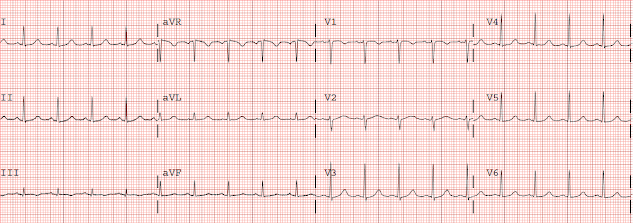I saw this as I was reading a large a stack of ECGs:
There is sinus tachycardia. The T-waves are slightly peaked, suggesting hyperkalemia. But what is atypical is that the T-wave in V3 towers over the R-wave. And there is terminal QRS distortion in lead V3 (meaning there is neither a J-wave nor an S-wave). The QTc is 462 ms. These are suspicious for hyperacute T-waves and anterior injury. The formula score is 24.8 (>23.4), also consistent with anterior injury.
The above is what I thought when I saw this, so I went to the chart and found this history:
A type I diabetic aged approximately 35 years old presented with chest pain, nausea, vomiting and diffuse abdominal pain. The patient was in DKA with an anion gap of 35, a glucose of 1128, and a K of 5.5 mEq/L.
pH = 7.17, pCO2 = 24, HCO3 = 8.
Her T-waves were attributed to hyperkalemia, without further investigation.
What do you think of this?
One would not expect such profound T-wave changes from a K of only 5.5.
The patient did have a serial troponins (they are automatically ordered on critically ill patients) and they rose to a peak of 12.4 ng/ml, which is too high for a typical critical illness without MI.
Here is her ECG the next day (with a normal K):
Because of the high troponin, echocardiography was done and showed a wall motion abnormality in the anterior, anterolateral, and apical walls, consistent with LAD myocardial infarction. Therefore, she underwent angiography and had a 95% LAD thrombotic culprit that, fortunately, had reperfused on its own (that's why the troponin was only 12). It was stented. Had it not opened on its own, it could have resulted in a very large anterior wall MI.
The possibility of anterior STEMI was not noticed during patient care. I noticed it much later on looking through a random stack of EKGs. I mention this only to point out that these findings can be noticed, and differentiated from more benign etiologies, prospectively.
This is NOT a retrospective finding.
Learning point:
Hyperacute T-waves and hyperkalemia may be confused, and they may be simultaneous. Here the potassium was barely high enough to result in a change in T-waves, so one should be especially suspicious in this case.
 |
| What do you think? |
There is sinus tachycardia. The T-waves are slightly peaked, suggesting hyperkalemia. But what is atypical is that the T-wave in V3 towers over the R-wave. And there is terminal QRS distortion in lead V3 (meaning there is neither a J-wave nor an S-wave). The QTc is 462 ms. These are suspicious for hyperacute T-waves and anterior injury. The formula score is 24.8 (>23.4), also consistent with anterior injury.
The above is what I thought when I saw this, so I went to the chart and found this history:
A type I diabetic aged approximately 35 years old presented with chest pain, nausea, vomiting and diffuse abdominal pain. The patient was in DKA with an anion gap of 35, a glucose of 1128, and a K of 5.5 mEq/L.
pH = 7.17, pCO2 = 24, HCO3 = 8.
Her T-waves were attributed to hyperkalemia, without further investigation.
What do you think of this?
 |
| T-waves are much more normal, less peaked, but also with better R-wave amplitude. The ST segment is back to 0. Equation value is 23.0. There is an S-wave in V3 now, although small. |
One would not expect such profound T-wave changes from a K of only 5.5.
The patient did have a serial troponins (they are automatically ordered on critically ill patients) and they rose to a peak of 12.4 ng/ml, which is too high for a typical critical illness without MI.
Here is her ECG the next day (with a normal K):
Because of the high troponin, echocardiography was done and showed a wall motion abnormality in the anterior, anterolateral, and apical walls, consistent with LAD myocardial infarction. Therefore, she underwent angiography and had a 95% LAD thrombotic culprit that, fortunately, had reperfused on its own (that's why the troponin was only 12). It was stented. Had it not opened on its own, it could have resulted in a very large anterior wall MI.
The possibility of anterior STEMI was not noticed during patient care. I noticed it much later on looking through a random stack of EKGs. I mention this only to point out that these findings can be noticed, and differentiated from more benign etiologies, prospectively.
This is NOT a retrospective finding.
Learning point:
Hyperacute T-waves and hyperkalemia may be confused, and they may be simultaneous. Here the potassium was barely high enough to result in a change in T-waves, so one should be especially suspicious in this case.

Thanks for the great post dr Smith! Isn't it wrong to use the formula, since there is terminal Qrs distortion?
ReplyDeleteGeorge,
DeleteThat is correct. It is ok to use it out of interest, but not to trust a negative result.
Steve